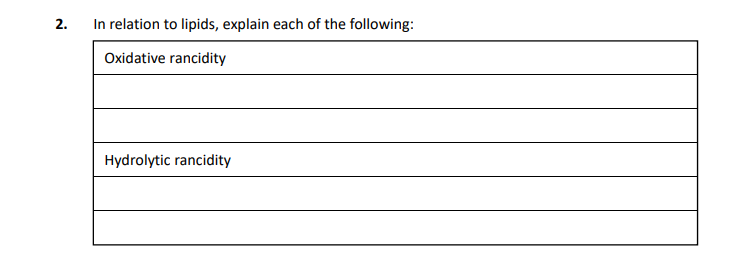Photo AI
In relation to lipids, explain each of the following: Oxidative rancidity Hydrolytic rancidity - Leaving Cert Home Economics - Question 2 - 2021
Question 2

In relation to lipids, explain each of the following: Oxidative rancidity Hydrolytic rancidity
Worked Solution & Example Answer:In relation to lipids, explain each of the following: Oxidative rancidity Hydrolytic rancidity - Leaving Cert Home Economics - Question 2 - 2021
Step 1
Oxidative rancidity
Answer
Oxidative rancidity occurs due to a reaction between unsaturated fatty acids and oxygen in the air. During this process, oxygen interacts with the carbon atoms at the double bonds in these fatty acids, leading to the formation of undesirable compounds such as aldehydes and ketones. These compounds produce unpleasant rancid odors and flavors, which can significantly affect the quality of food products.
Step 2
Hydrolytic rancidity
Answer
Hydrolytic rancidity is primarily caused by the action of enzymes known as lipases, which hydrolyze triglycerides into free fatty acids and glycerol. This process can also be facilitated by microorganisms such as bacteria present in fat foods. The hydrolysis can lead to the generation of off-flavors and unpleasant smells, which compromise the overall quality of the food products. Additionally, hydrolytic rancidity can occur during storage in freezers if enzymes are not adequately destroyed.
